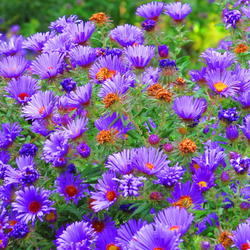
A riot of color. That's the rosy definition of my yard's unruly borders, where colorful annuals and self-seeded dill, parsley, and forget-me-not tumble together. "It's the cottage garden look," I kept telling my husband. "It's a mess," he repeated.
But when my mother-in-law retired, took up gardening, and in a few seasons transformed her yard into a floral Eden, I took stock. American landscaper T. H. Everett wrote, "The joy of being able to cut flowers freely, lavishly, to decorate the house and to give to friends, is an end that justifies a lot of gardening effort." My mother-in-law has that joy. My mess of flowers doesn't cut it.
So I polled floral experts across North America, looking for the best annual cut flowers. "I want flowers that are easy to grow and widely adapted with a long vase life," I told them. Though their cumulative choices topped six dozen, these eleven garnered top marks from California to Ontario.
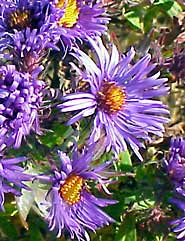
Vase life: 7 to 14 days. Easily grown and transplanted, asters reigned in the 1880s. But they don't bloom in six-packs for spring bedding plant sales, so marigolds and petunias have eclipsed them. Annual asters, also called China asters, flower in all colors but orange. They sport blooms 1- to 4-inches across on strong-stemmed plants 20- to 36-inches tall. Single-flowered types ('Single Marguerite', 'Single California Giant') look like multicolored daisies. Other China asters resemble pompons ('Giant Princess', 'Powderpuff') or peonies ('Opus'). No matter which shape you choose, one plant makes a bouquet.
Asters grow in all zones and flower from late July until hard frost, even in light shade and poor soil. Though most newer China asters are wilt resistant, you should change their location each year to prevent aster yellows, a disease that stunts plants and turns flowers a sickly chartreuse. Cut when flowers are half-open; recut stems underwater.
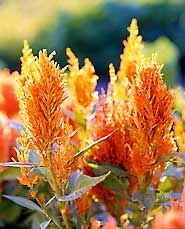
Vase life: 7 to 10 days. "Most celosias are easy to grow and look good both fresh and dried," says John Dole, assistant professor of floriculture at Oklahoma State University and co-chair of research for the Association of Specialty Cut Flowers. Skip dwarf bedding plants; you need celosias 20- to 40-inches tall for dramatic vertical accent in arrangements.
Cockscomb types (C. argentea cristata), such as 'Chief Mix', boast 6-inch, cauliflower-shaped heads in reds and golds. 'Century Mix' (C. a. plumosa), available in red, yellow, rose, and cream, is the number-one cutting favorite for Rosalind Creasy, landscape designer and author in Los Altos, California. "It has big, feathery, foot-long plumes. It's real easy to grow from seed and often self-seeds," she explains. Wheat celosia (C. a. spicata) is distinguished by long, narrow leaves and finger-length, wheatlike flower spikes in pink ('Flamingo Feather', 'Pink Candle') and white with red foliage ('Amazon').
Celosia flowers midsummer to frost. Cockscomb and plume types grow well in zones 2 to 11, if you keep the soil moist. Wheat types need long, warm summers (zone 6 and below) for optimum flowering, Dole says. Cut celosias when a quarter of the florets at the base are open. Dip stem ends in boiling water to extend vase life.
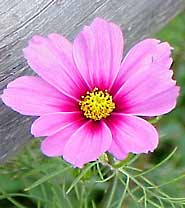
Vase life: 5 to 6 days. Eight weeks after seeding, cosmos start a lacy-leaved, free-flowering show that lasts till frost. These sun lovers grow in poor soil and tolerate hot, humid weather.
Butterflies adore the 2 1/2-inch, semidouble yellow, orange, and scarlet blooms of 'Bright Lights Mix' (C. sulphureus). 'Versailles' and 'Sensation' series (C. bipinnatus) send out 3-inch single blooms -- 4- to 6- inches wide -- in rose, crimson, pink and white. 'Seashells Mix' (C. bipinnatus) has tubular petals with fluted edges.
Cosmos, which thrive in zones 2 to 11, won third place in my informal survey. To stretch vase life, cut newly opened flowers, remove foliage, and plunge stems into lukewarm water for several hours before arranging them in a vase filled with cool water.
Gypsophila (G. elegans, G. viscosa)
Vase life: 5 to 8 days. "Gypsophila is very reliable. If I'm planning flowers for someone's wedding, I know it will always bloom six weeks after the day I seed it," says Ellen Ogden, flower trial consultant for The Cook's Garden in Londonderry, Vermont.
Also known as baby's breath, these starry blossoms on thread-thin stems make great fillers for fresh and dried arrangements. Among white-flowered types (G. elegans), 'Snow Fountain' is most upright and has strongest stems, and is most flowerful. 'Red Cloud' (G. viscosa) creates the same billowy effect in red and pink. Baby's breath rarely tops 2 feet.
Gypsophila blooms late spring to early fall, except during extreme heat, grows in all zones, and prefers sandy soil. Cut when one-third of flowers on stem have opened.
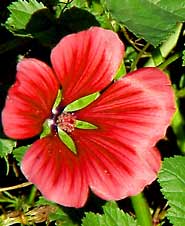
Vase life: 5 to 8 days. "This entrancing old flower has come back big time in Europe, and producers have developed new strains," says Mary Lee Johnson, flower trials manager of Johnny's Selected Seeds in Albion, Maine. "Lavatera deserves more attention because it gives a lot of bang for your buck," says Marilyn Barlow, proprietor of Select Seeds/Antique Flowers in Union, Connecticut. Also called mallow, the pure white ('White Beauty', 'Silver Cup') and ruby-veined pink ('Ruby Regis', 'Mont Rose') blossoms look like glossy hibiscus or hollyhocks. Maplelike leaves form bushy mounds of 24 to 48 inches. Flowers span 3 to 4 inches.
Suited to all zones, lavatera flowers from mid-July till hard frost in moist, fertile soil. Cut when several flowers have opened.
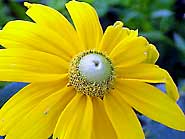
Vase life: 7 to 14 days. Known as gloriosa daisy, coneflower and black-eyed Susan, this favorite North American native species blooms nonstop -- even in partial shade -- from midsummer until frost. R. hirta 'Irish Eyes' has 5-inch, single yellow, green-eyed flowers. 'Indian Summers' is a 1995 All-America Selections winner; the black-eyed, gold-petaled beauty boasts single and semidouble blooms of 6 to 9 inches. Bicolored yellow, mahogany, bronze, and gold blooms distinguish 'Gloriosa Daisy Mix'. Most rudbeckias reach 24 to 42 inches.
Rudbeckia is tough. Technically a biennial or short-lived perennial, it is often treated as an annual. Hardy in all zones. Harvest flowers with tight centers, strip leaves, and condition in cool water spiked with sugar before arranging.
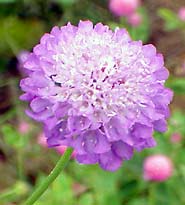
Vase life: 5 to 7 days. Also called mourning bride and pincushion flower (S. atropurpurea), these densely petaled, mounded blossoms span the spectrum from blue and lavender through pink and white. The fragrant, double, 3-inch flowers attract butterflies, too. The small, lavender-blue pincushions of S. stellata, known as starflower, ripen into coral-like bronze seedheads, perfect for drying. Scabiosas grow 24 to 48 inches tall.
Given moist, well-drained, fertile soil, Scabiosa will bloom summer to frost in all zones. Cut after most florets have opened, strip lower leaves, split stem ends, and condition in cold water before using as a filler or round accent in vase.
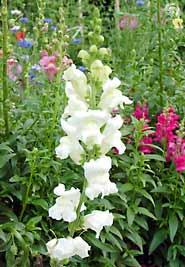
Vase life: 7 to 14 days. These brilliant spires evoke strong responses. Though they come in every shade but blue, many gardeners adore pure white and pale yellow because they work with any other color you grow. Others prefer single or open-faced snaps such as 'Bright Butterflies'. "Doubles look too gawky," he says. Stems of 18 to 36 inches provide much-needed spikiness in annual arrangements.
Snaps like partial shade in hot areas and fertile soil in all zones. Frowine suggests stretching layers of 4-by 4-inch mesh between corner posts over growing plants so stems will grow straight. The floral candelabras dazzle from late spring to frost. Bring a pail of cool water to the garden. Cut when lower flowers are open and dunk up to lowest flowers on stem. Recut stems under water.
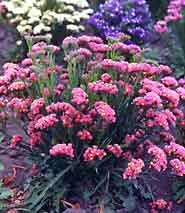
Vase life: 14 days. Given rich, well-drained soil, statice delivers crisp sprays with rainbow colors. This everlasting provides filler for fresh and dried displays. "Statice isn't the plant to buy at Wal-Mart," floriculture professor John Dale says. "It stunts in the flat very easily and should be transplanted before flower buds appear." Out West, annual 'Turbo' can be direct-seeded and will overwinter; all its intense colors bloom at once. Most L. sinuatum ('Soiree', 'Pacific', 'Turbo') grows 24- to 30-inches tall.
Russian statice (Psylliostachys suworowii) forms 18-inch-tall pink pokers perfect for nosegays. Statice blooms all summer until hard frost in every zone. Harvest during dry weather when most florets show color. Or, store statice in water and refrigerate for several weeks.
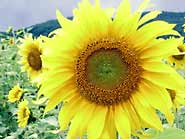
Vase life: up to 7 days. "Sunflowers are tough as nails. Anyone can grow them," says Steve Jones, flower seed manager at Bodger Seeds in southern California. Daylength-neutral 'Sunbeam' blooms in 60 days, no matter where sown. John Dole says commercial growers like 'Sonja,' an early, 3 1/2-foot plant with tangerine-orange blooms. Most sunflowers will top 5 feet unless you curtail height and flower size by closely spacing them in beds or whiskey barrels. New pollenless types ('Sunbeam', 'Sunbright', 'Sunrich Lemon' and 'Orange') are single-stemmed, cleaner to display in a vase and last longer than pollinated types. But you get more flowers per plant from branching 'Valentine' or 'Autumn Beauty', a mix that includes bronze, purple, and bicolors.
Given well-drained soil, sunflowers bloom all summer in every zone. Cut newly opened flowers; scald stem ends in boiling water.
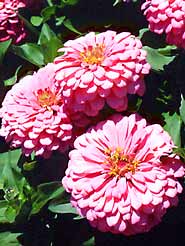
Vase life: 5 to 10 days. Talk about a sure thing. No matter what color (all but blue), blossom shape (button, single, double, dahlia, cactus), bloom size (1 to 8 inches) or height (10 inches to 3 feet) you choose -- zinnias grow easily from seed sown where you want plants to grow. Plants withstand heat and drought, and flourish summer to frost in zones 2 through 11. In my survey, only sunflowers got more votes than this reliable annual cut flower. Harvest long stems with tight flower heads; scald stem ends.
Extending Vase Life
If you want your cut flowers to last, try these tips from Lowell Ewart, professor of horticulture and All-America Selections flower trial judge at Michigan State University, and Anne Halpin and Betty Mackey, authors of Cutting Gardens (Simon & Schuster, 1993).
Joan Huyser-Honig has contributed many articles to National Gardening.
Photography by Suzanne DeJohn/National Gardening Association and Sabin Gratz/National Gardening Association